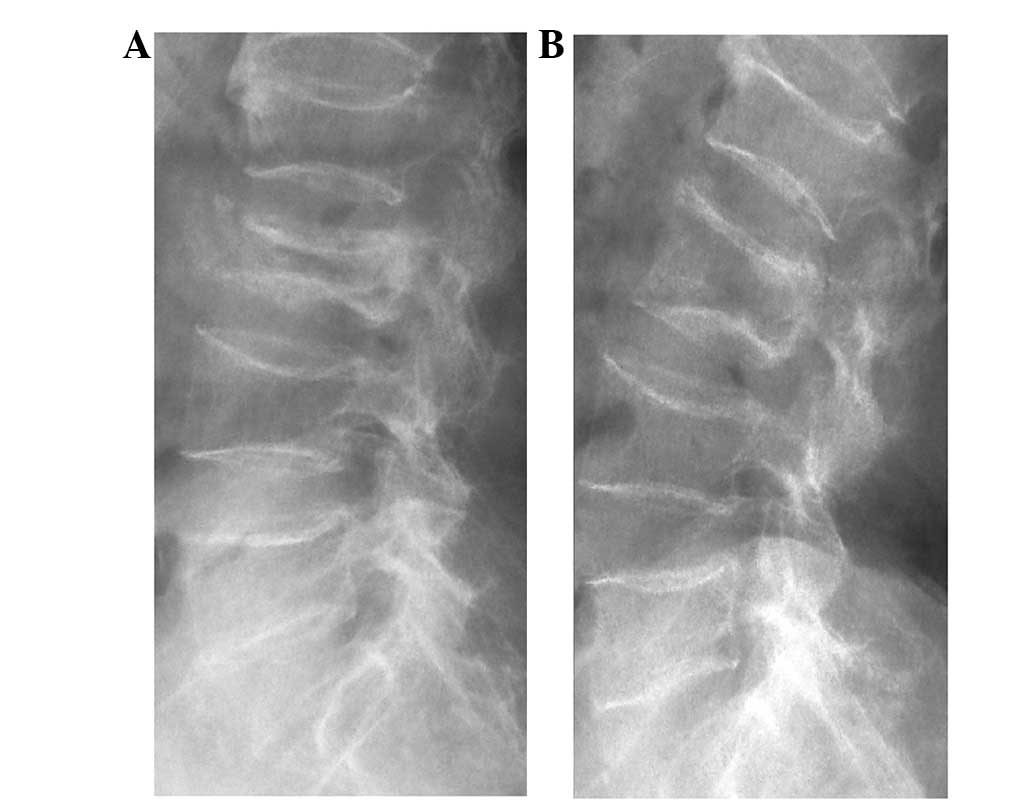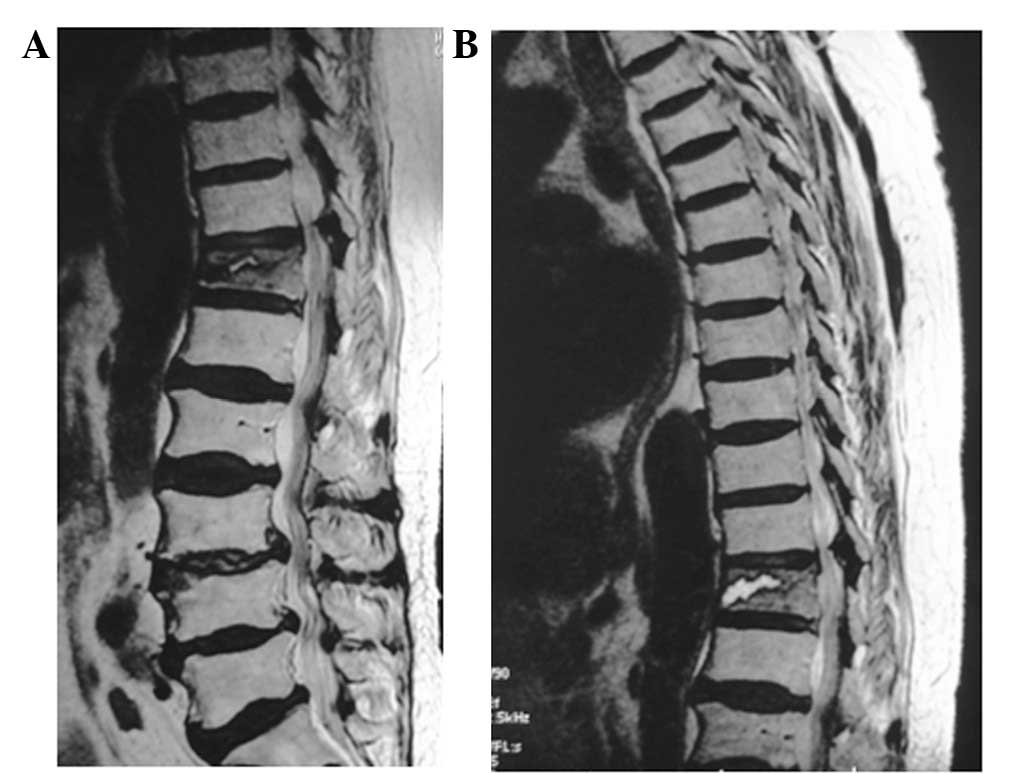|
1.
|
Kümmell H: Die rarefizierende Ostitis der
Wirbelkrper. Deutsche Med. 21:180–181. 1985.(in German).
|
|
2.
|
Kim KT, Suk KS, Kim JM and Lee SH: Delayed
vertebral collapse with neurological deficits secondary to
osteoporosis. Int Orthop. 27:65–69. 2003.PubMed/NCBI
|
|
3.
|
Saita K, Hoshino Y, Kikkawa I and Nakamura
H: Posterior spinal shortening for paraplegia after vertebral
collapse caused by osteoporosis. Spine (Phila Pa 1976).
25:2832–2835. 2000. View Article : Google Scholar : PubMed/NCBI
|
|
4.
|
Jang JS, Kim DY and Lee SH: Efficacy of
percutaneous vertebroplasty in the treatment of intravertebral
pseudarthrosis associated with noninfected avascular necrosis of
the vertebral body. Spine (Phila Pa 1976). 28:1588–1592. 2003.
View Article : Google Scholar : PubMed/NCBI
|
|
5.
|
Wang GL, Yang HL, Jiang WM, et al: Balloon
kyphoplasty for osteoporotic vertebral compression fractures with
osteonecrosis. Zhonghua Wai Ke Za Zhi. 48:593–596. 2010.(In
Chinese).
|
|
6.
|
Yang HL, Wang GL, Niu GQ, et al: Diagnosis
and treatment of nonunion of osteoporotic thoracolumbar vertebral
fractures. Chin J Orthop. 27:682–686. 2007.(In Chinese).
|
|
7.
|
Pappou IP, Papadopoulos EC, Swanson AN,
Cammisa FP Jr and Girardi FP: Osteoporotic vertebral fractures and
collapse with intravertebral vacuum sign (Kümmel’s disease).
Orthopedics. 31:61–66. 2008.PubMed/NCBI
|
|
8.
|
Malghem J, Maldague B, Labaisse MA, et al:
Intravertebral vacuum cleft: changes in content after supine
positioning. Radiology. 187:483–487. 1993. View Article : Google Scholar : PubMed/NCBI
|
|
9.
|
Feng SW, Chang MC, Wu HT, Yu JK, Wang ST
and Liu CL: Are intravertebral vacuum phenomena benign lesions? Eur
Spine J. 20:1341–1348. 2011. View Article : Google Scholar : PubMed/NCBI
|
|
10.
|
Liang D, Jiang XB, Yao ZS, et al: The
recent effects of PVP in treatment of Kümmell’s disease on
extension position. Zhongguo Ji Zhu Ji Sui Za Zhi. 20:260–261.
2010.(In Chinese).
|
|
11.
|
Zhang XK, Liang Y, Wu WJ, et al: Kümmell’s
disease: Reports of 7 cases and review of the literature. Anatomy
and Clinics. 16:127–130. 2011.(in Chinese).
|
|
12.
|
Kanayama M, Ishida T, Hashimoto T, et al:
Role of major surgery using Kanada anterior instrumentation for
osteoporotic vertebral collapse. J Spinal Disord Tech. 23:53–56.
2010. View Article : Google Scholar : PubMed/NCBI
|
|
13.
|
Mochida J, Toh E, Chiba M and Nishimura K:
Treatment of osteoporotic late collapse of a vertebral body of
thoracic and lumbar spine. J Spinal Disord. 14:393–398. 2001.
View Article : Google Scholar : PubMed/NCBI
|
|
14.
|
Suk SI, Kim JH, Lee SM, Chung ER and Lee
JH: Anterior-posterior surgery versus posterior closing wedge
osteotomy in post-traumatic kyphosis with neurologic compromised
osteoporotic fracture. Spine (Phila Pa 1976). 28:2170–2175. 2003.
View Article : Google Scholar
|
|
15.
|
Uchida K, Nakajima H, Yayama T, et al:
Vertebroplasty-augmented short-segment posterior fixation of
osteoporotic vertebral collapse with neurological deficit in the
thoracolumbar spine: comparisons with posterior surgery without
vertebroplasty and anterior surgery. J Neurosurg Spine. 13:612–621.
2010. View Article : Google Scholar
|
|
16.
|
Sudo H, Ito M, Abumi K, et al: One-stage
posterior instrumentation surgery for the treatment of osteoporotic
vertebral collapse with neurological deficits. Eur Spine J.
19:907–915. 2010. View Article : Google Scholar : PubMed/NCBI
|
|
17.
|
Fuentes S, Blondel B, Metellus P,
Adetchessi T, Gaudart J and Dufour H: Open kyphoplasty for
management of severe osteoporotic spinal fractures. Neurosurgery.
64(5 Suppl 2): 350–354. 2009. View Article : Google Scholar : PubMed/NCBI
|
|
18.
|
Matsuyama Y, Goto M, Yoshihara H, et al:
Vertebral reconstruction with biodegradable calcium phosphate
cement in the treatment of osteoporotic vertebral compression
fracture using instrumentation. J Spinal Discord Tech. 17:291–296.
2004. View Article : Google Scholar
|
|
19.
|
Maldague BE, Noel HM and Malghem JJ: The
intravertebral vacuum cleft: a sign of ischemic vertebral collapse.
Radiology. 129:23–29. 1978. View
Article : Google Scholar : PubMed/NCBI
|
|
20.
|
Lafforgue P, Chagnaud C, Daumen-Legré V,
Daver L, Kasbarian M and Acquaviva PC: The intravertebral vacuum
phenomenon (‘vertebral osteonecrosis’). Migration of intradiscal
gas in a fractured vertebral body? Spine (Phila Pa 1976).
22:1885–1891. 1997.
|
|
21.
|
Laredo JD: Expert’s comment concerning
Grand Rounds case entitled ‘Kümmell’s disease: delayed
post-traumatic osteonecrosis of the vertebral body’ (by R. Ma, R.
Chow, F. H. Shen). Eur Spine J. 19:1071–1072. 2010.
|
|
22.
|
Wagner AL and Baskurt E: Refracture with
cement extrusion following percutaneous vertebroplasty of a large
interbody cleft. AJNR Am J Neuroradiol. 27:230–231. 2006.PubMed/NCBI
|
|
23.
|
Wang HS, Kim HS, Ju CI and Kim SW: Delayed
bone cement displacement following balloon kyphoplasty. J Korean
Neurosurg Soc. 43:212–214. 2008. View Article : Google Scholar : PubMed/NCBI
|














